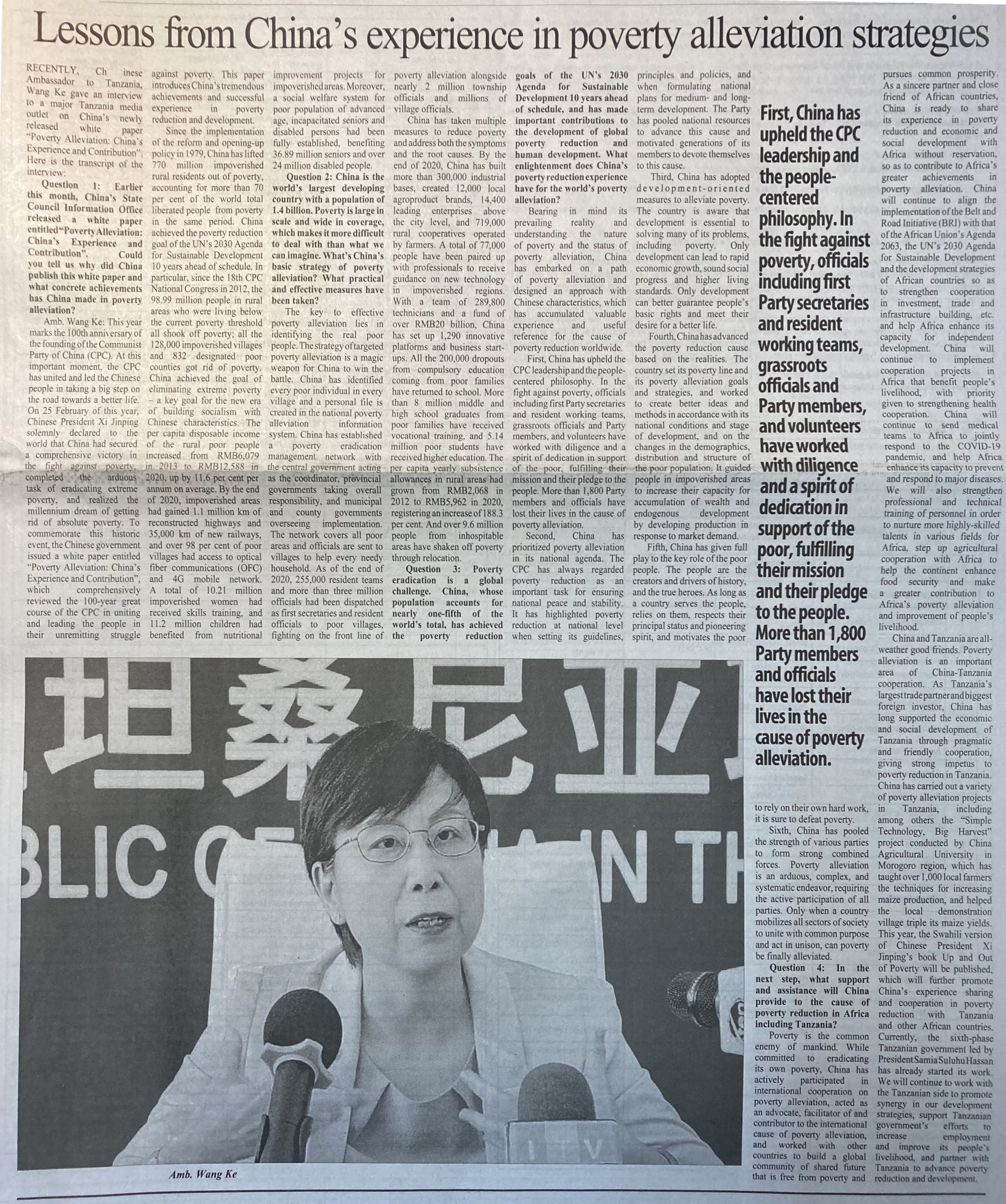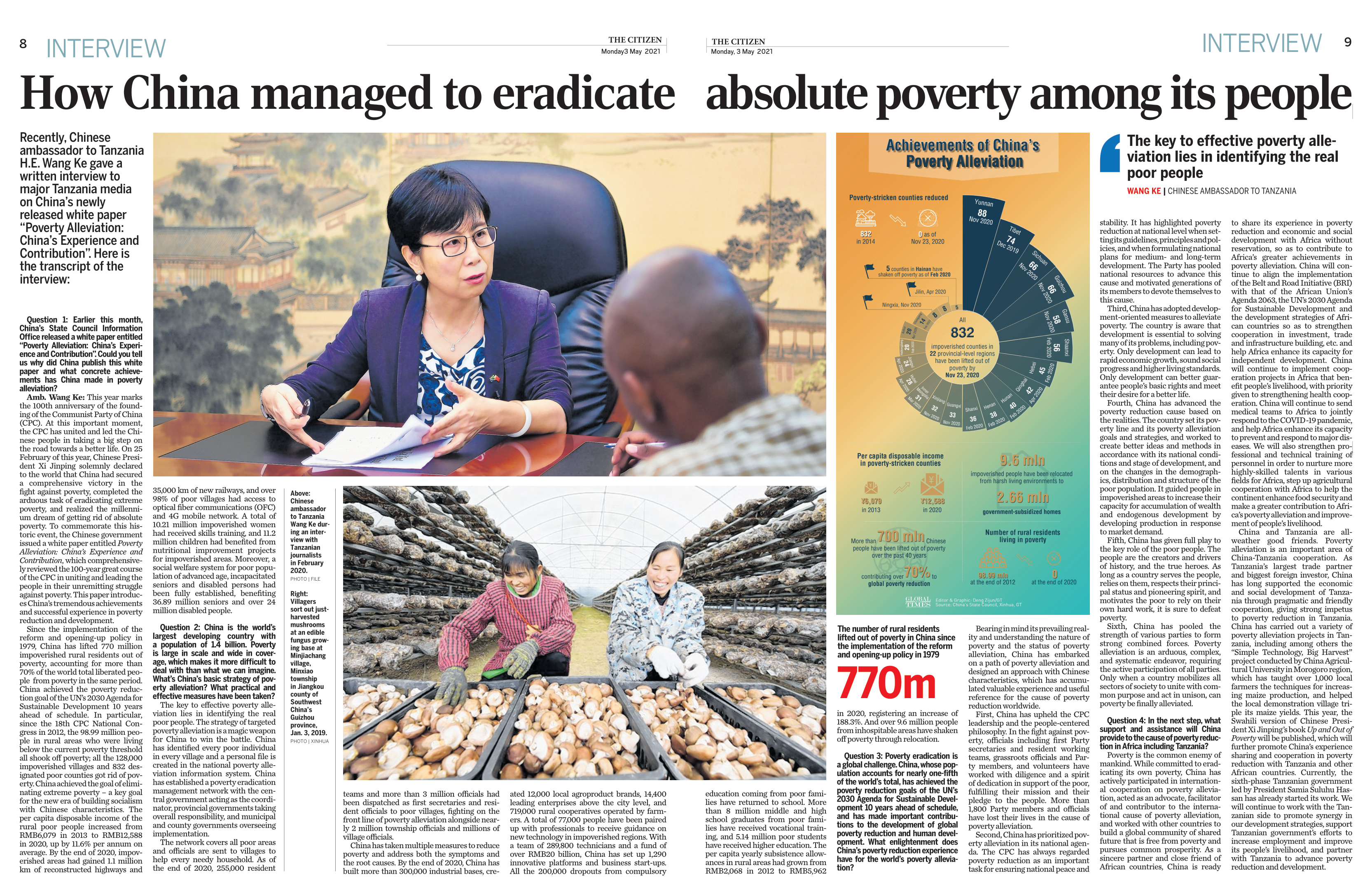Last week, Chinese Ambassador to Tanzania H.E. Wang Ke gave an written interview to major Tanzanian English newspapers, namely Daily News and The Citizen, on China’s White Paper “Poverty Alleviation: China’s Experience and Contribution”. Here is the full text of the interview.


Question 1: Earlier this month, China’s State Council Information Office released a white paper entitled “Poverty Alleviation: China’s Experience and Contribution”. Could you tell us why did China publish this white paper and what concrete achievements has China made in poverty alleviation?
Amb. Wang Ke: This year marks the 100th anniversary of the founding of the Communist Party of China (CPC). At this important moment, the CPC has united and led the Chinese people in taking a big step on the road towards a better life. On 25 February of this year, Chinese President Xi Jinping solemnly declared to the world that China had secured a comprehensive victory in the fight against poverty, completed the arduous task of eradicating extreme poverty, and realized the millennium dream of getting rid of absolute poverty. To commemorate this historic event, the Chinese government issued a white paper entitled “Poverty Alleviation: China’s Experience and Contribution”, which comprehensively reviewed the 100-year great course of the CPC in uniting and leading the people in their unremitting struggle against poverty. This paper introduces China’s tremendous achievements and successful experience in poverty reduction and development.
Since the implementation of the reform and opening-up policy in 1979, China has lifted 770 million impoverished rural residents out of poverty, accounting for more than 70% of the world total liberated people from poverty in the same period. China achieved the poverty reduction goal of the UN’s 2030 Agenda for Sustainable Development 10 years ahead of schedule. In particular, since the 18th CPC National Congress in 2012, the 98.99 million people in rural areas who were living below the current poverty threshold all shook off poverty; all the 128,000 impoverished villages and 832 designated poor counties got rid of poverty. China achieved the goal of eliminating extreme poverty – a key goal for the new era of building socialism with Chinese characteristics. The per capita disposable income of the rural poor people increased from RMB6,079 in 2013 to RMB12,588 in 2020, up by 11.6% per annum on average. By the end of 2020, impoverished areas had gained 1.1 million km of reconstructed highways and 35,000 km of new railways, and over 98% of poor villages had access to optical fiber communications (OFC) and 4G mobile network. A total of 10.21 million impoverished women had received skills training, and 11.2 million children had benefited from nutritional improvement projects for impoverished areas. Moreover, a social welfare system for poor population of advanced age, incapacitated seniors and disabled persons had been fully established, benefiting 36.89 million seniors and over 24 million disabled people.
Question 2: China is the world’s largest developing country with a population of 1.4 billion. Poverty is large in scale and wide in coverage, which makes it more difficult to deal with than what we can imagine. What’s China’s basic strategy of poverty alleviation? What practical and effective measures have been taken?
The key to effective poverty alleviation lies in identifying the real poor people. The strategy of targeted poverty alleviation is a magic weapon for China to win the battle. China has identified every poor individual in every village and a personal file is created in the national poverty alleviation information system. China has established a poverty eradication management network with the central government acting as the coordinator, provincial governments taking overall responsibility, and municipal and county governments overseeing implementation. The network covers all poor areas and officials are sent to villages to help every needy household. As of the end of 2020, 255,000 resident teams and more than 3 million officials had been dispatched as first secretaries and resident officials to poor villages, fighting on the front line of poverty alleviation alongside nearly 2 million township officials and millions of village officials.
China has taken multiple measures to reduce poverty and address both the symptoms and the root causes. By the end of 2020, China has built more than 300,000 industrial bases, created 12,000 local agroproduct brands, 14,400 leading enterprises above the city level, and 719,000 rural cooperatives operated by farmers. A total of 77,000 people have been paired up with professionals to receive guidance on new technology in impoverished regions. With a team of 289,800 technicians and a fund of over RMB20 billion, China has set up 1,290 innovative platforms and business start-ups. All the 200,000 dropouts from compulsory education coming from poor families have returned to school. More than 8 million middle and high school graduates from poor families have received vocational training, and 5.14 million poor students have received higher education. The per capita yearly subsistence allowances in rural areas had grown from RMB2,068 in 2012 to RMB5,962 in 2020, registering an increase of 188.3%. And over 9.6 million people from inhospitable areas have shaken off poverty through relocation.
Question 3: Poverty eradication is a global challenge. China, whose population accounts for nearly one-fifth of the world’s total, has achieved the poverty reduction goals of the UN’s 2030 Agenda for Sustainable Development 10 years ahead of schedule, and has made important contributions to the development of global poverty reduction and human development. What enlightenment does China’s poverty reduction experience have for the world’s poverty alleviation?
Bearing in mind its prevailing reality and understanding the nature of poverty and the status of poverty alleviation, China has embarked on a path of poverty alleviation and designed an approach with Chinese characteristics, which has accumulated valuable experience and useful reference for the cause of poverty reduction worldwide.
First, China has upheld the CPC leadership and the people-centered philosophy. In the fight against poverty, officials including first Party secretaries and resident working teams, grassroots officials and Party members, and volunteers have worked with diligence and a spirit of dedication in support of the poor, fulfilling their mission and their pledge to the people. More than 1,800 Party members and officials have lost their lives in the cause of poverty alleviation.
Second, China has prioritized poverty alleviation in its national agenda. The CPC has always regarded poverty reduction as an important task for ensuring national peace and stability. It has highlighted poverty reduction at national level when setting its guidelines, principles and policies, and when formulating national plans for medium- and long-term development. The Party has pooled national resources to advance this cause and motivated generations of its members to devote themselves to this cause.
Third, China has adopted development-oriented measures to alleviate poverty. The country is aware that development is essential to solving many of its problems, including poverty. Only development can lead to rapid economic growth, sound social progress and higher living standards. Only development can better guarantee people’s basic rights and meet their desire for a better life.
Fourth, China has advanced the poverty reduction cause based on the realities. The country set its poverty line and its poverty alleviation goals and strategies, and worked to create better ideas and methods in accordance with its national conditions and stage of development, and on the changes in the demographics, distribution and structure of the poor population. It guided people in impoverished areas to increase their capacity for accumulation of wealth and endogenous development by developing production in response to market demand.
Fifth, China has given full play to the key role of the poor people. The people are the creators and drivers of history, and the true heroes. As long as a country serves the people, relies on them, respects their principal status and pioneering spirit, and motivates the poor to rely on their own hard work, it is sure to defeat poverty.
Sixth, China has pooled the strength of various parties to form strong combined forces. Poverty alleviation is an arduous, complex, and systematic endeavor, requiring the active participation of all parties. Only when a country mobilizes all sectors of society to unite with common purpose and act in unison, can poverty be finally alleviated.
Question 4: In the next step, what support and assistance will China provide to the cause of poverty reduction in Africa including Tanzania?
Poverty is the common enemy of mankind. While committed to eradicating its own poverty, China has actively participated in international cooperation on poverty alleviation, acted as an advocate, facilitator of and contributor to the international cause of poverty alleviation, and worked with other countries to build a global community of shared future that is free from poverty and pursues common prosperity. As a sincere partner and close friend of African countries, China is ready to share its experience in poverty reduction and economic and social development with Africa without reservation, so as to contribute to Africa’s greater achievements in poverty alleviation. China will continue to align the implementation of the Belt and Road Initiative (BRI) with that of the African Union’s Agenda 2063, the UN’s 2030 Agenda for Sustainable Development and the development strategies of African countries so as to strengthen cooperation in investment, trade and infrastructure building, etc. and help Africa enhance its capacity for independent development. China will continue to implement cooperation projects in Africa that benefit people’s livelihood, with priority given to strengthening health cooperation. China will continue to send medical teams to Africa to jointly respond to the COVID-19 pandemic, and help Africa enhance its capacity to prevent and respond to major diseases. We will also strengthen professional and technical training of personnel in order to nurture more highly-skilled talents in various fields for Africa, step up agricultural cooperation with Africa to help the continent enhance food security and make a greater contribution to Africa’s poverty alleviation and improvement of people’s livelihood.
China and Tanzania are all-weather good friends. Poverty alleviation is an important area of China-Tanzania cooperation. As Tanzania’s largest trade partner and biggest foreign investor, China has long supported the economic and social development of Tanzania through pragmatic and friendly cooperation, giving strong impetus to poverty reduction in Tanzania. China has carried out a variety of poverty alleviation projects in Tanzania, including among others the “Simple Technology, Big Harvest” project conducted by China Agricultural University in Morogoro region, which has taught over 1,000 local farmers the techniques for increasing maize production, and helped the local demonstration village triple its maize yields. This year, the Swahili version of Chinese President Xi Jinping’s book “Up and Out of Poverty” will be published, which will further promote China’s experience sharing and cooperation in poverty reduction with Tanzania and other African countries. Currently, the sixth-phase Tanzanian government led by President Samia Suluhu Hassan has already started its work. We will continue to work with the Tanzanian side to promote synergy in our development strategies, support Tanzanian government’s efforts to increase employment and improve its people’s livelihood, and partner with Tanzania to advance poverty reduction and development.